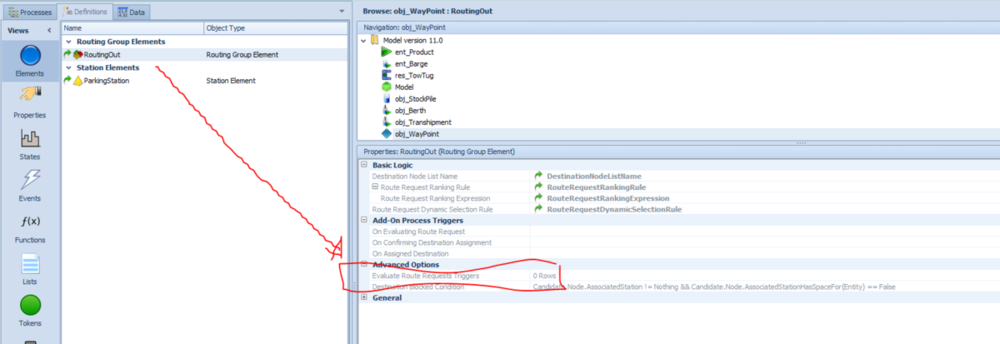Search the Community
Showing results for 'buffer transfer node'.
-
Hello everybody, I'm trying to make this work but I cant Type/Conteiner BinBig BinMed BinSmall Product1 1 1 - Product2 - 1 1 Product3 1 - 1 Product4 1 1 1 I want to make a node where these entities (Products and Bins) are convined in one batch, I try to use a process based in decitions and search.. the file is attached if you wanna take a look on it.. (the product have to be the parent) OptimoContenedores2.spfx
-
Hello everyone, I have a simple production line of 15 servers, some combiners, nothing too complicated. I need to somehow setup the input buffer at each server to have 1 entity at the start of the simulation and then run it. Or having filled servers with 1 entity at each server. Could anyone please help me and show me how to set it up? I need to start counting the stats once all the workstations are filled, but warmup period does not seem to work for that case, because it destroys the enitities at the servers and starts over. The filled-input-buffer-way looked to me like the easiest solution. But if there is another way, please let me know. Thank you!
-
My simulation is looking at maintaining inventory levels at multiple servers across a road network. Inventory is delivered via transports and is processed at each station at a rate of 1 item per hour (constant). What I am trying to do is to run some experiments to determine effects of different parameters on delivery system performance (ability to maintain inventory at (between 0-12) at each server location for the duration (72 hours is the current short test case). I have my responses set up to report Input@Server1.AssociatedStationLoad however the numbers are being listed between 0 and 1 instead of 0 and 12. Additionally, in the experiment output I get a 1 or 0 per server per scenario iteration. What I need to see is if any (and what) server hits 0 at any given time by having an output give an inventory level at current time for the duration of each run. Any advice?
-
I am trying to make a routing decision based on the Candidate node's routerequestqueue's summation of the entities user-defined property. If there are different types of entities with ex. different priority levels. I would like the routing process to choose the transfernode which has the smallest total sum of it's entities priority level. the transfernode that needs to be chosen also has a routing group attached to its entity destination type rule where its final machine has 0 buffer and due to a blocked destination rule, there will be a queue build up at the transfernode that needs to be chosen. I have thought about using a state variable for each node and using add-on process each time a unit enters and leaves a node but because the main model has many multiple nodes the node's entity priority sum has to be able to be accessed through the candidate.transfernode._________________. For example during the routing step in the process section, I have candidate.transfernode.destinationroutinggroupname.routerequestqueue which gives me the node's number of units waiting, but i need to be able to access the candidate nodes summed queued property. Is there either a way to directly access this information, have looked at the expressions and having a hard time finding something. failed attempt: candidate.transfernode.destinationroutinggroupname.routerequestqueue.population.defaultentity.priority.summation or is there a way to use the add-on process where i am adding/subtracting the priority levels, but somehow attach it to the candidate.transfernode's property Hopefully this makes sense. If you look at the file, please ignore the upper half and focus on the transfer nodes maintransfer, transfernode1 and transfernode1_1. maintransfer has an entered add-onprocess which is the subject of this question. the route process and it's selection expression is what I'm trying to adjust but find a way to express the candidate transfernodes of transfernode1 and transfernode1_1 (which are part of the XferRouting group). I'd like to choose and compare the total summed priority level of each node's queue. Simple_Routing.spfx
- 2 replies
-
- routing
- expressions
-
(and 2 more)
Tagged with:
-
Hi All,
In my model, I have a transfer node and the entity could go to either of the next 2 serves as in the picture.
I have assigned product number(1,2,3...) to entities …., if product “1” moves from transfer node to S1 and the next product is also “1”, it should also move to S1 and if the product number changes its should change the server to S2. So the entire batch gets processed on one server.
After processing from S1 and S2 the entity should flow in batch so that at S3 I have batch production
Right now the entities go based on “By Link Weight” and randomly goes to the server which affects S1,S2,S3 servers setup time
Any thoughts how can that be achieved, I do not want to setup a sequence table.
-
Hi All,
I have defined the input buffer capacity and output buffer capacity for my servers, If the input buffer of destination server is full the vehicle still picks the entity(from output buffer of previous server) and moves to the destination(next) server and just waits with the entity unless input buffer capacity is available , how can I restrict the forklift from not picking up the entity or should only pick when the next server/destination has input buffer capacity available. any thoughts on this would be helpful.
-
I'm having some trouble with worker actions and transfer steps. Below is a picture of my current model. I have also attached the simio file itself. What I want to happen: Worker1 carries both entities to their respective nodes and leaves them in their respective stations after worker(A/B) "checks them" (I used a delay to simulate this check) and then Worker1 moves on. The worker(A/B) only picks up the entity if needed. So if the worker was with another entity in process (like Srv(A/B)), he would go check the new entity so that worker1 can move on, but would return to finish out the first entity to the end. My problem: Worker1 doesn't wait for the other workers to check and move on, just puts in station and moves on. I can suspend and resume the processes and get the worker to the (A/B)PICK nodes, but the worker picks the new entity up and starts that. The entity they were working on before just vanishes or something. Then everything becomes a standstill. Lastly, I run into this transfer error so much, and can never figure out exactly what causes it. ModelForQuestionCOPY2.spfx
- 2 replies
-
- transfernode
- worker
-
(and 1 more)
Tagged with:
-
Hi I need reference to some sort of property that can help me store entities in my transfer node(shelf). I have used the Park property but then I am not sure on how I can release it when the transporter is told to arrive at the transfer node(shelf) to pick up certain of those parked entities. Any help is appreciated. Thank you
-
Hello, I'm college student preparing the contest sponsored by "KOREA SOCIETY FOR SIMULATION". So I'm making model which has no input buffer , just remaining on the path. But the issue is that, if i set the input buffer as 0, the source makes entities only two, which is the sum of the sever's capacity.... I have seen that kind of model at the jsmith.co , but my model doesn't act like that.. What should I do for my model? isThereInputBufferCapa.spfx
-
Hello, Server (reflecting the storage/kitting area) in my push model is connected to multiple servers. I have below conditions to fulfill while routing entities from an output node of this server - After every 5 minutes, 1. Scan through the sequenced entities at kitting area (output buffer) 2. Scan through the output destinations to check if they have space available for transfer. 3. Route all the possible parts in sequence from the origin server. Can someone help with advice or any reference model to replicate this scenario in Simio. Thanks in advance. -Mohmed
-
Hello All, I am new to Simio and trying out a simulation of an aircraft component assembly shop. I am using Sequence table for my jobs routing and processing scenarios which is - Source -> Set A (4 servers) -> Set B (7 servers) -> Set C (5 servers) -> Set D (2 servers) -> Sink Here each Set denotes similar workbenches to any of which a job can be routed based on utilization and availability at that point of time. So for routing job based on above criteria from Source, I created sequence table with 'Node list property' (which is list of input nodes on 4 servers of Set A) instead of 'SequenceDestination Property' as required by Sequence table. I want to replicate the sequencing from Source -> Set A -> Set B and so on. But want simio to pick the server of these sets based on my criterion. Unfortunately it is not working as I assume Sequence table need to have specific node as SequenceDestination. I am not sure if I am doing it right or what is correct and way to do it. I will highly appreciate any suggestions to make this happen in Simio. Thank you. -Mohmed
-
Hi, In the modell I'm working on I have a set of sources that generate different types of entities and two workers that have to grab those entities and trasport then to another node. The decision of which source is unloaded first is defined by a specific probability distribution. However, I don´t know where to define this decision to route the worker. Could someone please help?
-
I have entity1 and entity2 entering a server. I want entity1 to have priority over entity2 when in the input buffer waiting to be processed no matter how many entities are already in the input buffer. I'm using connectors leading the entities into the server input node. Any suggestions?
-
To model shelves, I am trying to create a series of custom "Shelf" objects (subclass of servers) located in a grid pattern. I used a spreadsheet to automatically calculate the coordinate locations and generate a name (string) for each object based on its position within the grid. With just the Shelf object types in the spreadsheet, can bind the file to my object reference table no problem, import the data, and populate the facility window with my objects. That part works fine! Next, since I have an aisle running between the rows of objects, I wanted to set it up so that the objects all face "inwards", ie. the input and output nodes for the objects are facing the aisle. Originally I thought of rotating the Shelf object, but I ran into 2 issues: first, I discovered that I can't set the Shelf yaw orientation from the table, so that's not going to work. Second, I realized that even when I rotate the Shelf in the facility window, the nodes do not rotate with their parent object. I decided I would leave the Shelf in the same orientation as it is placed, but I would just re-locate the input/output nodes to the opposite edge of the Shelf objects on the far side of the aisle. For this I would need to make sure I can set locations for the input/output nodes in the same object reference table. When I added a row to the object reference table from within Simio (prior to binding to a spreadsheet), a drop down appeared, and I could select the input or output nodes for any object that already existed in the table, and then define the node's location in the cartesian coordinate columns. When creating a node this way, the node location is still relative to the object, ie. I can drag the object in the facility window and the node moves relative to the object, which is perfect. This input/output node creation and relative location definition via table is exactly what I am trying to automate, but this is where I started running into problems. In my spreadsheet I used formulas to generate names for the nodes to match the formatting of the input and output nodes in Simio (ex. "Input@..."/"Output@..."). I also added a formula to assign all input node object types to BasicNodes and all output nodes to TransferNodes and calculate the desired location coordinates for the nodes. The spreadsheet I made has the same format as the table in Simio where I tested manually creating and positioning the nodes. The issue is that when I bind the table and import the spreadsheet data to my model, the node names automatically change and are no longer formatted to reference the parent object. Because of this, these name-changed node objects are created in addition to the input and output nodes that are created for each Shelf object. However, if I remove the binding and add a new row, once again I can find the node name in the drop down list and assign the coordinates manually, and the input/output node that references the parent object will move to where I send it. My question is: how can I set the input/output node locations for the objects when creating objects from a table? There are over 500 Shelf objects in the table so I do not want to locate them manually, but the automated method is not working either. The only idea that I have is to make a new object "Shelf2" and define the external view to have the nodes on the opposite side, but that seems like a less-than-idea solution because then I would have 2 custom objects to update and maintain, that are otherwise identical. I am hoping that I don't have to do this hacky solution but I am interested to see if anyone else has dealt with this and has ideas. Thanks!
-
I need to simulate a crane moving entities between different points. But the problem is the load and unload time are not the same in all those points. I need to be able to define somehow the crane load & unload time as a variable (node depending). I wonder if anyone has dealed with this problem before? Rds.
-
How do you use the transfer step to bring an entity from a path to another node. Currently at the reached end condition of the path I created a Transfer Step process that moves it to another node. I keep getting the error "The entity's current location '[EndOfLink] Path3' is invalid for attempting the specified transfer request". When I set From to EndOfLink I cannot fill any 'To' options. What do I do?
-
Any chance anyone knows how to access or circumvent the Route Requests Triggers of the default Routing Group within a node ??
-
Hi all, in my model I have a specific transfer node where a worker transfers an entity to a vehicle. I cant add the load unloading times in the worker or vehicle due to the fact that there is only loading time in this transfer point exactly. I was wondering if there is a way to directly add a "processing time" to this transfer point. Maybe by creating a subclass? Thanks
-
Hello, I'm modeling an orange factory. One thing that I'm trying to solve is the modeling of the reception pools (of oranges). 1) Arrive trucks. 2) The truck is weight. Every truck have a random value of kilograms of oranges. (integer) 3) The truck dispose the oranges in a workstation. (workstation = reception pool). This is model with a Separator. 3.1) There are 3 workstation. 3.2) Every workstation has diferent Input Buffers. 3.3) The entity once entered in MemberOut@Separator1, it triggers a decide process. 3.3.1) This decide is to choose the workstation depending of the Quantity of Oranges versus the Input Buffer. Now I need to Wait until the Input Buffer is Empty, but I'm having problems with that, because the entities don't release from this server. If there are doubts about the model or anything else, I will answer as fast as possible. test1.spfx
-
Hi All, Used simio a couple of years back and in the process of trying to refresh my skills. I am trying to model a synchronous transfer model in a manufacturing setup. Synchronous meaning - entities will only transfer downstream only after all the entities are processed in their respective servers. Any ideas on which tools to use is highly appreciated. Running a bit tight on time. Thanks all
-
Hi I have draw a Conveyor and conntected it to a InputNode of Server. Now I have to change the model and connect the Conveyor to another BasicNode. How can I do this without removing and redrawing the conveyor?
-
I have two models in a project, one which handles supply (results in trucks being routed to one of several sinks) and one which handles demand (various sources). I would like to connect the sink of my supply model to the source of the demand model. Can I transfer entities between models? Or do I need to manually copy and paste each object from one of my models into the other to allow for the transfer of entities? This may be very simple, sorry if I'm the annoying newbie! Joy
-
Hello Simio Forum. I’m just starting a model which, for me, is a little unique as I have only used servers in a task capacity through steps. The new liquid ink model consists of 4 lines with each line made up of 3 steps each having a volume of 3.5 tonnes. 1. PreMix 2. Mill with a recirc tank 3. PostBlend I do not seem to be able to model this using servers because I cannot represent the transfer time of product occupancy between steps. I need this to show utilisation/uptime of the steps. But when I look at using "Flow" tanks I cant add the process tasks the same as servers (rows) i.e. gather weigh, milling time, QC etc.. Plus will need to add/link worker steps. Is there a middle ground between servers & tanks? Thanks Martin
-
Hello All, I'm trying to create a model that will keep track of processing time for each transaction processed and reroute transactions that exceed a processing time threshold to an alternate sink. Initially, I attempted to rework the "Remove from Allocation Queue" Simbit, but the "Remove" process only seems to work with queues. The model itself is very simple. Single source with a random exponential inter-arrival time, single processor with capacity of 50 and 2 sinks; one for completed transactions and one for long running transactions which are manually routed. Any guidance you can provide would be greatly appreciated. Thank you, Ryan
-
I'm addressing a Multi Product Multi Routing situation. What's the best way to model a buffer without using the Server or WorkStation blocks? N machines are connected to M machines producing different products with alternative routing. Therefore, having a common buffer where entities coming from different machines could wait for the first available machine in any alternative route is very important. My question is whether this would perform better with stations or storages (or any other object in Simio). I intend to experiment on Buffer size to optimize space requirements. This would be done using experiments hence the chosen object/method needs to be suitable for that. Scheme: [n1] ___________ [m1] [n2] | | [m2] [n3] | Buffer | . . |___________| . . [M ] [N ] Thank you in advance







